|
|
|||
|
(Back to Preceding Week; on to Next Week) |
|
WHEN IT'S DREARY AND COLD |
|
FLEDGLING BIRDS:
Baby vertebrates--from primates to puppies and geese to geckos--often look quite different from adults, if only because they have different body proportions. In humans, for example, the ratio of head height to body height is about 1:6, while in neonates the ratio is 1:4; this gives the baby human--or that just-hatched lizard--a big-headed look that may evoke an instinctive paternal response.
All text & photos © Hilton Pond Center While still in the nest, baby birds typically have very brightly colored bill and throat linings. As a chick opens its mouth to vocalize or beg, the parent bird sees a flash of orange, red, or yellow--a "target zone" that shows where to stuff the next juicy grub or worm. In many altricial species--as in the Eastern Tufted Titmouse above--fledglings temporarily retain colored target zones that change to gray or white or even black as the youngster matures. (Note also the backward-facing barbs in the rear of the titmouse's throat, an adaptation that apparently keeps live insects from crawling back out.)
All text & photos © Hilton Pond Center The bright color of a nestling's mouth lining typically extends to the edge of the bill and to the juncture of the upper and lower mandibles--an area known as the "gape." In young birds the gape is very soft and noticeable but in a fledgling it begins to harden somewhat, become less prominent, and--like the bill itself--darken with age. (In some bird species--Purple Finches, for example--the adult retains a yellow gape, albeit smaller and less obvious.)
Some birds exhibit remarkable change in bill color, as in Northern Cardinals. Fledglings such as the unsexed cardinal above have very dark bills that eventually become bright orange as the youngster begins to forage on seeds and berries containing carotene it lays down in the bill sheath. The titmouse and cardinal above and young House Finch below also illustrate another common characteristic of nestlings/recent fledglings--a sort of "natal plume" that consists of one or more wispy feathers that sprout from head or nape. To us, such plumes--especially noticeable in older nestlings--look really out of place in a fledgling. These non-essential feathers typically break off or fall out within a week or so after a bird leaves its nest, so their presence is a fairly precise indicator of a youngster's age.
All text & photos © Hilton Pond Center The House Finch photo above reveals another common characteristic of fledglings: The contour (body) feathers are loosely structured and give the young bird a disheveled look. It's not that fledglings haven't yet learned how to preen but that their first feathers have poorly formed vanes and barbs and barbules. Thus, young birds often do not have the sleek and smooth appearance of the adult--a characteristic that may continue for several months or more until the fledgling gets its first full set of "adult" feathers. (Herein we use the word "adult" rather flexibly to mean a bird older than a recent fledgling.)
All text & photos © Hilton Pond Center Sometimes those loosely structured juvenile feathers have entirely different markings than the bird will have as an adult, as in the young Carolina Wren above. In this species, the crissum--
All text & photos © Hilton Pond Center Although it's not a songbird, a recently fledged Downy Woodpecker also has different plumage than it will show as an adult--at least as far as head feathers are concerned. Show the photo above to many birders and they will tell you it depicts a male downy because there's a red spot on the head. Unfortunately, that logic is incorrect.
All text & photos © Hilton Pond Center We didn't catch any fledgling Ruby-throated Hummingbirds this week, but we'll still take this opportunity to mention the ruby-throat is another non-songbird in which juvenile males do NOT look like adult males (right). For an extreme example of a young bird whose plumage (and eye color) is very different from that of its parents, take a gander at the photo above. We suspect this fledgling looks so unlike the adult many birders will not immediately recognize its species. (As an aside, note the tooth-like projection on the lower mandible, apparently a structure that makes quick work of big seeds--or hard-bodied beetles.) After you think you know what the species and sex of this bird might be--or if you simply give up before accepting our challenge to check every single page in your field guide to figure it out--click on the image above to open a new window in your browser. (REWARD: Give yourself a pat on the binoculars if you were able identify this mystery fledgling right off, and TWO pats if you made the effort to look through your guide to make the ID.)
All text & photos © Hilton Pond Center And speaking of eye color, that truly IS a characteristic that differs significantly between fledglings and adults. Many fledglings have what we call "muddy" eyes in which irises are dull and not very sparkly. As the eye matures, the crystalline make-up of the iris changes, muddiness clears, and color generally deepens. In some cases, however, there is a drastic and quite noticeable change in eye color, as when the gray-eyed fledgling Brown Thrasher (above) acquires brilliant yellow irises as an adult (right).
All text & photos © Hilton Pond Center The last fledgling on our list this week is one that looks COMPLETELY different from its parents. In fact, even when this fledgling matures and becomes an adult it STILL won't look like its parents--or at least like its step-parents. That's because the youngster above is a fledgling Brown-headed Cowbird, a so-called social parasite that lays its eggs in the nests of other bird species. All text & photos © Hilton Pond Center
Comments or questions about this week's installment?
Thanks to the following fine folks for recent gifts in support of Hilton Pond Center for Piedmont Natural History and/or Operation RubyThroat: The Hummingbird Project. Your tax-deductible contributions allow us to continue writing, photographing, and sharing "This Week at Hilton Pond." (Please see Support if you'd like to make a gift of your own. You can also contribute by ordering an Operation RubyThroat T-shirt.)
"This Week at Hilton Pond" is written & photographed You may wish to consult our Index of all nature topics covered since February 2000. You can also use our on-line Hilton Pond Search Engine at the bottom of this page. For a free, non-fattening, on-line subscription to |
|
Make direct donations on-line via
Network for Good: |
|
|
Use your PayPal account
to make direct donations: |
|
|
If you like to shop on-line, you please become a member of iGive, through which more than 750 on-line stores from Barnes & Noble to Lands' End will donate a percentage of your purchase price in support of Hilton Pond Center and Operation RubyThroat. For every new member who signs up and makes an on-line purchase iGive will donate an ADDITIONAL $5 to the Center. Please sign up by going to the iGive Web site; more than 200 members have signed up to help. It's a painless, important way for YOU to support our on-going work in conservation, education, and research. |
|
|
SPECIES BANDED THIS WEEK: * = New species for 2009 WEEKLY BANDING TOTAL 13 species 42 individuals YEARLY BANDING TOTAL (2009) 32 species 1,029 individuals 28-YEAR BANDING GRAND TOTAL (since 28 June 1982, during which time 170 species have been observed on or over the property) 124 species 52,911 individuals NOTABLE RECAPTURES THIS WEEK (with original banding date, sex, and current age) Ruby-throated Hummingbird (2) Carolina Wren (1) House Finch (1) Eastern Towhee (1)
|
OTHER NATURE NOTES OF INTEREST --The first orange blossoms on the Center's Trumpet Creeper vines appeared this week, a few days later than normal but still in plenty of time for the earliest fledgling hummers to take full advantage of the flowers' heavy nectar load. --Above-average rains continued at the Center, bringing the weekly total to 5.25," with 12.5" for the past fortnight. That's a LOT of rain--so much that it may be drowning the mosquitoes. (We can only hope!) Hilton Pond is overflowing at the spillway and things look really, really green--a welcome change from the ultra-dry Junes we've had more often than not in the past decade or two.
--One way we can tell when you've had a lot of rain at Hilton Pond Center is when the Sunflower seeds in the feeder trays start to sprout in less than 48 hours. --To view our archived essay on Brown-headed Cowbirds (mentioned above), see Black Vagabond.
|
|
|
|
(Back to Preceding Week; on to Next Week) Up to Top of Page Back to This Week at Hilton Pond Center Current Weather Conditions at Hilton Pond Center |
 You can also post questions for The Piedmont Naturalist |
Join the |
Search Engine for |
|
|
diabetic diet

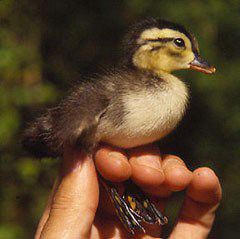 (In other words, adults think baby animals are "cute.") Baby birds are also quite different in appearance from their parents, whether it be precocial (ready-to-swim) Wood Ducklings (left) that hatch covered with soft, fluffy down or altricial Eastern Bluebirds coming out of the egg helpless and completely naked. We don't catch many precocial waterfowl at Hilton Pond Center, but in the past week or two we did net and band some recently fledged songbirds--several of which appear so different from their parents they can be difficult to identify. In any case, all these fledglings definitely "look their age."
(In other words, adults think baby animals are "cute.") Baby birds are also quite different in appearance from their parents, whether it be precocial (ready-to-swim) Wood Ducklings (left) that hatch covered with soft, fluffy down or altricial Eastern Bluebirds coming out of the egg helpless and completely naked. We don't catch many precocial waterfowl at Hilton Pond Center, but in the past week or two we did net and band some recently fledged songbirds--several of which appear so different from their parents they can be difficult to identify. In any case, all these fledglings definitely "look their age."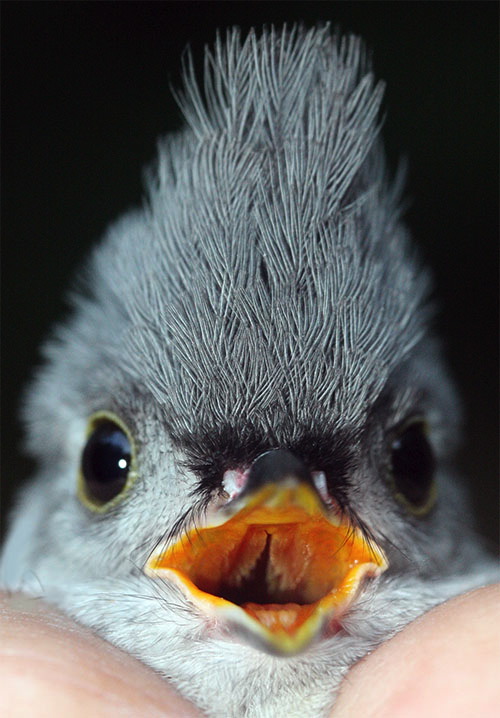
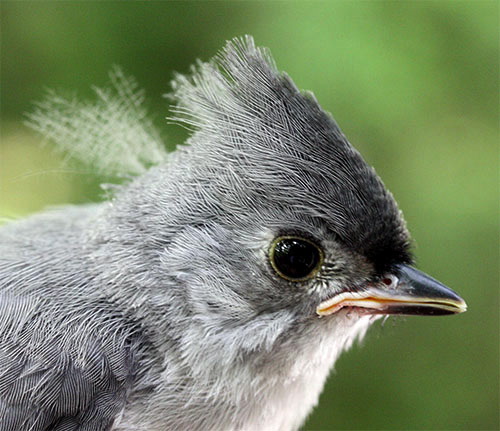
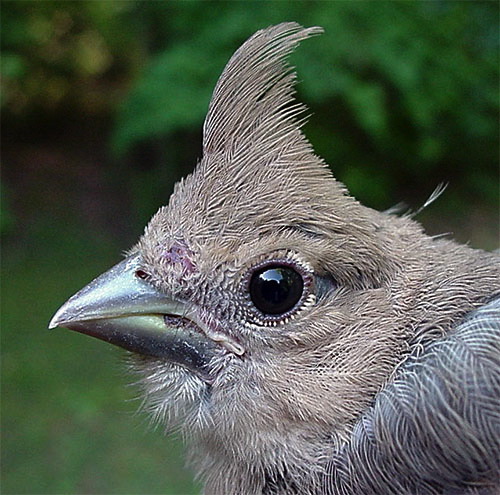
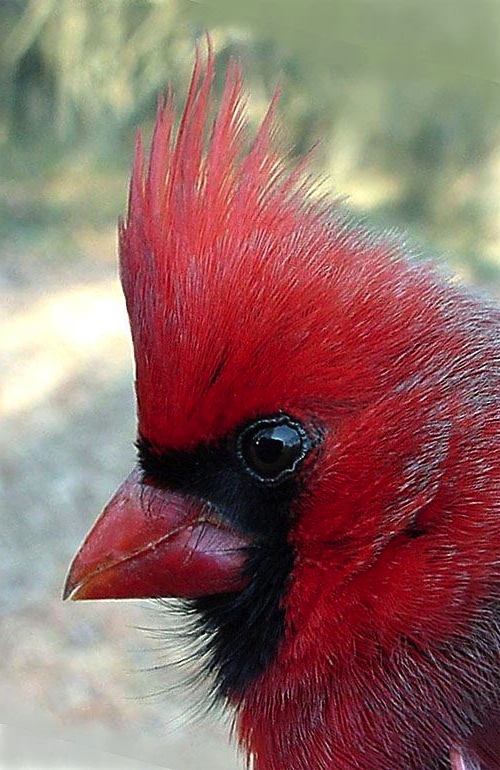 Curiously, adult cardinals (male, left) quit processing yellow-orange pigment during the non-breeding season, so bill color in winter birds gradually fades until it resembles that of juveniles. The same thing happens in American Goldfinches.
Curiously, adult cardinals (male, left) quit processing yellow-orange pigment during the non-breeding season, so bill color in winter birds gradually fades until it resembles that of juveniles. The same thing happens in American Goldfinches.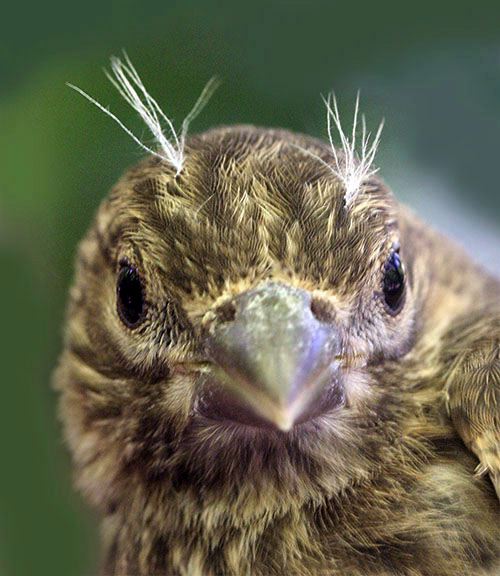

 the short, tan-colored plumage that overlaps the underside of the dark rusty tail feathers--is not only poorly formed but uniformly light brown. When the fledgling molts these soft undertail coverts--usually by late in its first summer--stronger adult feathers that replace them are whiter and bear prominent dark bars (above right). These marks match the barring characteristic of plumage in most members of the wren family.
the short, tan-colored plumage that overlaps the underside of the dark rusty tail feathers--is not only poorly formed but uniformly light brown. When the fledgling molts these soft undertail coverts--usually by late in its first summer--stronger adult feathers that replace them are whiter and bear prominent dark bars (above right). These marks match the barring characteristic of plumage in most members of the wren family.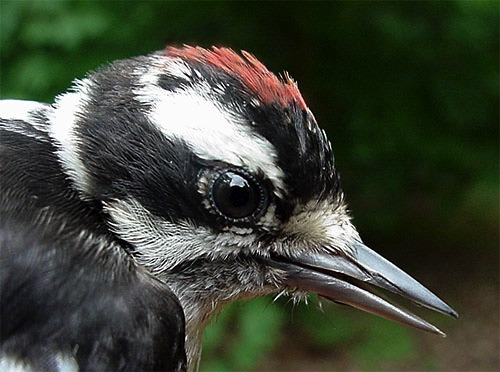
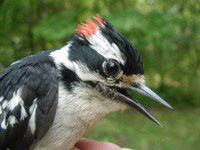 This is actually a photo of a young Downy Woodpecker, a species in which both males AND females have red topknots as nestlings and for up to a month or longer after they fledge. Eventually these red crown feathers fall out and the male downy acquires red--but on his NAPE (left). The adult female is completely white and black with no red feathers at all. We suspect parent downies recognize red-crowned birds as youngsters and will feed them rather than chasing them off as adult competitors. (If it hasn't happened already, an enterprising student could probably test this hypothesis in the field.)
This is actually a photo of a young Downy Woodpecker, a species in which both males AND females have red topknots as nestlings and for up to a month or longer after they fledge. Eventually these red crown feathers fall out and the male downy acquires red--but on his NAPE (left). The adult female is completely white and black with no red feathers at all. We suspect parent downies recognize red-crowned birds as youngsters and will feed them rather than chasing them off as adult competitors. (If it hasn't happened already, an enterprising student could probably test this hypothesis in the field.)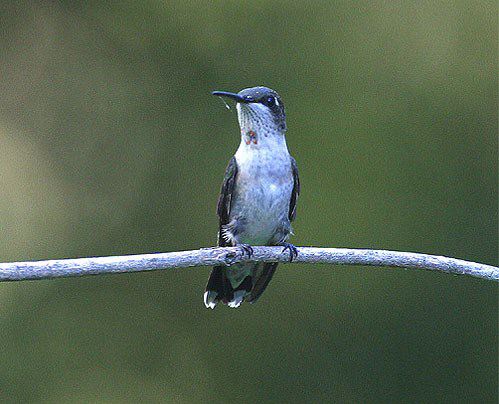
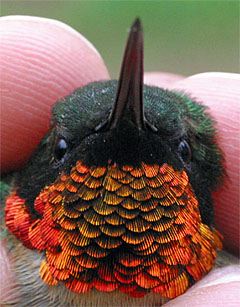 In this species, the young male (above) lacks a full red gorget and, in fact, resembles its white-throated mother--even sporting the white-tipped outer tail feathers found in all females. Most--but not all--young males of the year have at least a hint of dark green or black streaking on their throats, and some will acquire one or more red gorget feathers before departing for the Neotropics in autumn. That said, except for early spring before the current year's youngsters fledge, one should NEVER assume a white-throated Ruby-throated Hummingbird is a female; here in the Carolinas, after about mid-May the hummer very well could be a fledgling male. (That young male ruby-throats look like females probably reduces potential hazardous territorial encounters with adult males.)
In this species, the young male (above) lacks a full red gorget and, in fact, resembles its white-throated mother--even sporting the white-tipped outer tail feathers found in all females. Most--but not all--young males of the year have at least a hint of dark green or black streaking on their throats, and some will acquire one or more red gorget feathers before departing for the Neotropics in autumn. That said, except for early spring before the current year's youngsters fledge, one should NEVER assume a white-throated Ruby-throated Hummingbird is a female; here in the Carolinas, after about mid-May the hummer very well could be a fledgling male. (That young male ruby-throats look like females probably reduces potential hazardous territorial encounters with adult males.)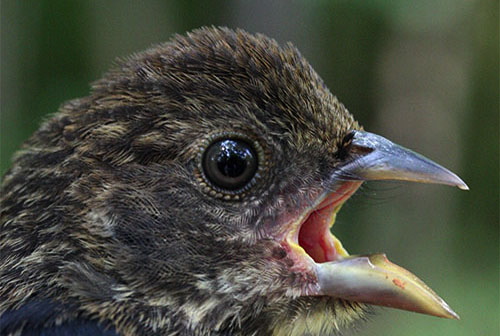
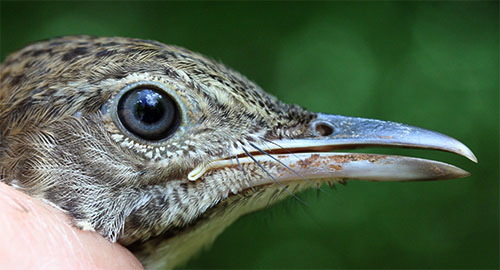
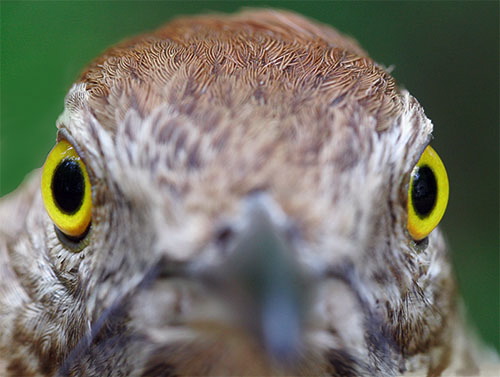 Such drastic color change in thrashers and other species may take a couple of years; as shown, older thrashers sometimes get a red outer ring around the iris. (Note in the image of the juvenile thrasher above the fleshy gape and loose structure of the facial feathers--already discussed as typical characteristics of recent fledglings. The juvenile thrasher also has a paler, less distinct face--a characteristic found in many young birds. Lastly, you can see rictal bristles protruding forward from the base of the young thrasher's bill. We've always suspected these highly modified feathers--present in other species as well--serve primarily to keep legs of insect prey from scratching a bird's eyes.)
Such drastic color change in thrashers and other species may take a couple of years; as shown, older thrashers sometimes get a red outer ring around the iris. (Note in the image of the juvenile thrasher above the fleshy gape and loose structure of the facial feathers--already discussed as typical characteristics of recent fledglings. The juvenile thrasher also has a paler, less distinct face--a characteristic found in many young birds. Lastly, you can see rictal bristles protruding forward from the base of the young thrasher's bill. We've always suspected these highly modified feathers--present in other species as well--serve primarily to keep legs of insect prey from scratching a bird's eyes.)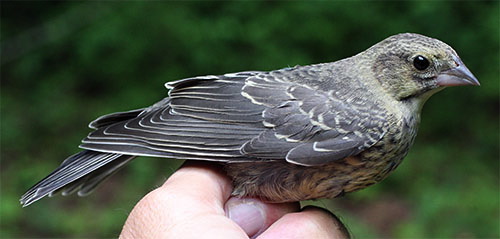
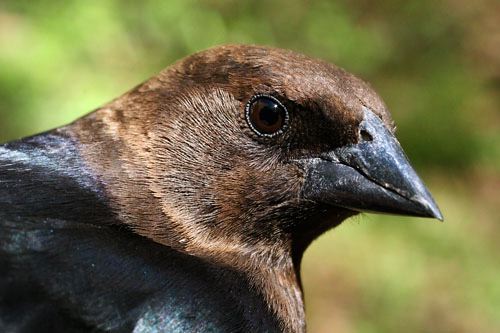 This week we mist netted two of these dull, mottled gray-brown birds; their presence means some other possibly less common bird species ended up caring for cowbirds--perhaps instead of producing a new generation of their own offspring. We've written previously concerning our mixed emotions on Brown-headed Cowbirds (adult male, above left) so we won't elaborate, opting instead to simply repeat that at Hilton Pond Center--and elsewhere--natal-plumed, muddy-eyed, brightly mouthed fledgling birds usually look their age, sometimes even without revealing their species.
This week we mist netted two of these dull, mottled gray-brown birds; their presence means some other possibly less common bird species ended up caring for cowbirds--perhaps instead of producing a new generation of their own offspring. We've written previously concerning our mixed emotions on Brown-headed Cowbirds (adult male, above left) so we won't elaborate, opting instead to simply repeat that at Hilton Pond Center--and elsewhere--natal-plumed, muddy-eyed, brightly mouthed fledgling birds usually look their age, sometimes even without revealing their species. 

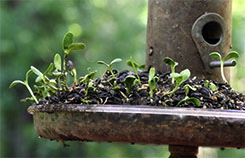
 Please report your
Please report your